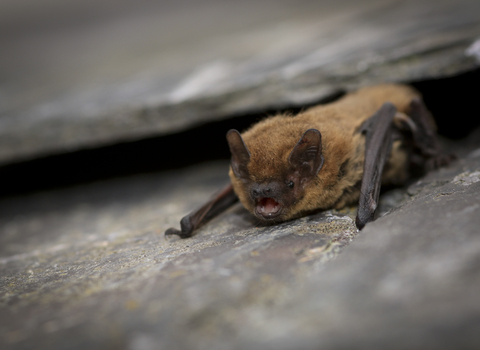
©Tom Marshall
Common pipistrelle
Scientific name
Pipistrellus pipistrellusWhen to see
April to OctoberSpecies information
Category
Statistics
Length: 3.5-4.5cmWingspan: 20-23cm
Weight: 3-8g
Average lifespan: 4-5 years
About
The common pipistrelle is our smallest and most common bat. All UK bats are nocturnal – preferring to come out only at night. They feed on midges, moths and other flying insects that they find in the dark by using echolocation. Common pipistrelles don’t have to look far to find food, whether they live in the countryside or the city!They roost in tree holes, bat boxes and even the roof spaces of houses, often in small colonies. During the summer, females form maternity colonies and have just a single pup each. Look out for common pipistrelles darting about as they hunt for insects in gardens or around streetlights just after sunset. They hibernate over winter, usually between November and April, but may come out to feed on warm days.
How to identify
The common pipistrelle has dark, golden-brown fur, a slightly paler underside and a dark mask around the face. Its flight is rapid with lots of twists and turns. The soprano pipistrelle is similar in appearance, so the two can be difficult to tell apart.Distribution
Widespread, but absent from Shetland and parts of Orkney.In our area
Common pipistrelles and their close relatives, soprano pipistrelles, are one of the few bat species present on the Isles of Scilly. They are the easiest to see in the summer, when the females form maternity colonies. They give birth to a single young in June or early July. For three or four weeks the young are fed solely on their mother’s milk. After about four weeks the young are able to fly and at six weeks they are able to forage for themselves. They are on the wing from April to October, but on Scilly they may be seen feeding during the winter months, too due to our warmer climate. They feed in a wide range of habitats comprising woodland, hedgerows, grassland, farmland, suburban and also urban areas. You can often see them using the warmer areas over tarmac or concrete roads with close hedges or flittering across the beaches whilst feeding at dusk.
The Big Scilly Bat Survey is an innovative project led by the Isles of Scilly Wildlife Trust and the Isles of Scilly Bat Group, and funded by the Isles of Scilly AONB and supported by Bat Conservation Trust. We are using state of the art technology developed by the British Trust for Ornithology (BTO) to help answer a few questions, including what bat species live on the islands, which species are resident, which are seasonal visitors and the favourite foraging grounds on different islands. We want to help bats thrive on Scilly, so understanding their ecology is the first step.
Did you know?
It was only discovered in the late 1990s that there are actually two very closely related species of pipistrelle bat - common and soprano - both originally grouped as Pipistrellus pipistrellus. They are distinguished by the different frequency of their echolocation calls. A third species of pipistrelle, a slightly larger bat called Nathusius' pipistrelle, is also found in the UK.Common pipistrelles and their close relatives, soprano pipistrelles, are one of the few bat species present on the Isles of Scilly. They are the easiest to see in the summer, when the females form maternity colonies. They give birth to a single young in June or early July. For three or four weeks the young are fed solely on their mother’s milk. After about four weeks the young are able to fly and at six weeks they are able to forage for themselves. They are on the wing from April to October, but on Scilly they may be seen feeding during the winter months, too due to our warmer climate. They feed in a wide range of habitats comprising woodland, hedgerows, grassland, farmland, suburban and also urban areas. You can often see them using the warmer areas over tarmac or concrete roads with close hedges or flittering across the beaches whilst feeding at dusk.
The Big Scilly Bat Survey is an innovative project led by the Isles of Scilly Wildlife Trust and the Isles of Scilly Bat Group, and funded by the Isles of Scilly AONB and supported by Bat Conservation Trust. We are using state of the art technology developed by the British Trust for Ornithology (BTO) to help answer a few questions, including what bat species live on the islands, which species are resident, which are seasonal visitors and the favourite foraging grounds on different islands. We want to help bats thrive on Scilly, so understanding their ecology is the first step.
